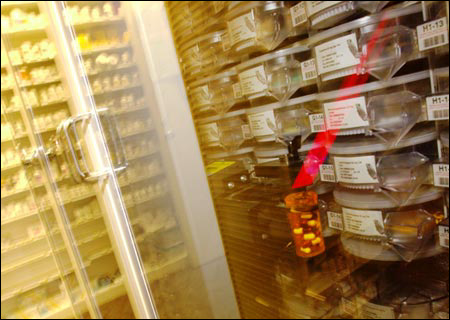Robot fills prescriptions at UHS
Technology of the future ushers in a personal touch of the past

In an industry long associated with the old-fashioned corner store, the pharmacy at Harvard University Health Services (HUHS) only recently stepped into the 21st century. Actually, with HUHS’ latest modernization – the state-of-the-art SP 200 Robotic Prescription Dispensing System – which uses barcode technology, a robotic arm, and an electronic eye to fill and label between 150 and 200 prescriptions per day – the Harvard pharmacy, located in the Holyoke Center arcade, seems to have skipped this century altogether. And yet, the pharmacy’s core mission is more “1950” than ever before.
Together with SP Central, the system interface that manages the pharmacy’s prescription flow, the SP 200 from ScriptPro of Mission, Kan., nearly eliminates the tedious and time-consuming task of counting pills and filling vials. By cutting off a minute and a half per fill, the SP 200 (aka, “the robot”) – a large, refrigerator-like receptacle holding nearly 200 drugs in different “cells” or containers – frees up pharmacists to work more directly with patients in the consultation process. With more time to dedicate to customer questions and concerns, HUHS pharmacists aim to bring back the personal touch of a seemingly bygone era.

“It’s amazing,” said HUHS Director of Pharmacy Maureen McCarthy of the new technology, which fills more than 40 percent of the pharmacy’s orders. Since the robot’s installation this past March, “The pharmacy staff never wants to go back,” she said, equating the technological leap of the old system to the SP 200 to that of a typewriter to a computer. And with more reliable and streamlined service, it is unlikely customers of the pharmacy would ever want to go back either.
Here’s how it works. Immediately after a prescription is put into the pharmacy’s computer system, a robotic arm located inside the refrigerator-like tank determines the correct vial size for that given order. By scanning a bar code positioned beside the cell, the robotic arm – with vial “in hand” – verifies the desired drug. With the specific drug confirmed, the arm pushes the vial against a tiny chute located on the cell. The pills then drop into the vial while they are simultaneously counted by an electric eye located within the arm. As the robot’s final step, the arm places the vial on a short conveyer belt where the patient label and medication warning sticker are applied.
As a safeguard, pharmacists twice verify the vial’s contents against a computer screen image of the drug. At SP Central – the system’s brains made up of a row of computers – the pharmacists also double check that the patient, dosage, and drug all match up. With the safeguard process complete, computer monitors located in the pharmacy’s waiting room alert waiting customers that their order is ready for pick up.
According to McCarthy, a pharmacist since 1979, the new system not only reduces errors and miscommunication among pharmacists, but also straightens out, with far greater efficiency, any snarl that might occur in a bustling operation such as the HUHS pharmacy. McCarthy recalls one instance in which a patient suffering from Alzheimer’s couldn’t recall whether she had picked up her prescription. Within seconds, SP Central was able to verify, via an onscreen display of the patient’s signature, that she had in fact picked up her medication a week before – a task that would have taken 15 minutes in the old computer and paper system, according to McCarthy.
Nearly 6 months old, “the robot” is still without a name. HUHS is currently accepting submissions to name “the robot.” Submissions may be sent to mmccart@uhs.harvard.edu.




